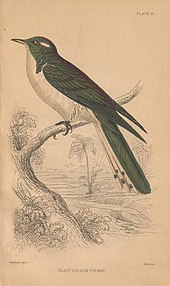
The western plantain-eater, also known as the grey plantain-eater or western grey plantain-eater, is a large member of the turaco family, a group of large arboreal near-passerine birds restricted to Africa.

The white-naped woodpecker is woodpecker which is a widespread but a scarce breeder in the Indian Subcontinent. It is associated with open forest and scrub with some trees. It nests in a tree hole, laying one or two white eggs.

François Levaillant was a French author, explorer, naturalist, zoological collector, travel writer, and noted ornithologist. He described many new species of birds based on birds he collected in Africa and several birds are named after him. He was among the first to use colour plates for illustrating birds and opposed the use of binomial nomenclature introduced by Carl Linnaeus, preferring instead to use descriptive French names such as the bateleur for the distinctive African eagle.
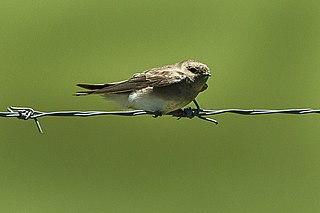
The brown-throated martin or brown-throated sand martin is a small passerine bird in the swallow family, Hirundinidae, that is widely distributed across Africa. It was formerly regarded as conspecific with the grey-throated martin and the Madagascar martin.

The diederik cuckoo, formerly dideric cuckoo or didric cuckoo is a member of the cuckoo family of birds, Cuculidae, which also includes the roadrunners and the anis.
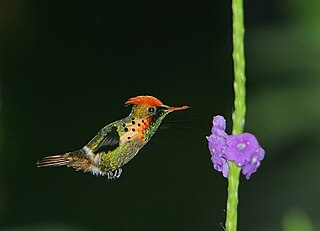
The tufted coquette is a tiny hummingbird that breeds in eastern Venezuela, Trinidad, Guiana, and northern Brazil. It is an uncommon but widespread species, and appears to be a local or seasonal migrant, although its movements are not well understood.

The greater ani is a bird in the cuckoo family. It is sometimes referred to as the black cuckoo. It is found through tropical South America south to northern Argentina.

The guira cuckoo, known in Spanish as the pirincho is a species of gregarious bird found widely in open and semi-open habitats of northeastern, eastern and southern Brazil, Uruguay, Paraguay, Bolivia, and northeastern Argentina. It is the only species placed in the genus Guira.

The African pygmy goose is a perching duck from sub-Saharan Africa. It is the smallest of Africa's waterfowl, and one of the smallest in the world.

The mangrove cuckoo is a species of cuckoo that is native to the Neotropics.

The great-billed parrot also known as Moluccan parrot or island parrot, is a medium-sized, approximately 38 cm long, green parrot with a massive red bill, cream iris, blackish shoulders, olive green back, pale blue rump and yellowish green underparts. The female is typically smaller than the male, but otherwise the sexes are similar.

The greater striped swallow is a large swallow that is native to Africa south of the equator.

The tractrac chat is a small passerine bird of the Old World flycatcher family Muscicapidae. It is a common resident breeder in southernmost Angola, western Namibia and western South Africa.

The little sparrowhawk is a species of Afrotropical bird of prey in the family Accipitridae. It was formerly placed in the genus Accipiter. It is the smallest member of the genus Tachyspiza and forms a superspecies with the red-thighed sparrowhawk.

The Asian emerald cuckoo is a species of cuckoo in the family Cuculidae. It is found in Bangladesh, Bhutan, Cambodia, China, India, Indonesia, Laos, Malaysia, Myanmar, Nepal, Sri Lanka, Thailand, and Vietnam. Its natural habitats are subtropical or tropical moist lowland forests and subtropical or tropical moist montane forest.

The violet-backed starling, also known as the plum-coloured starling or amethyst starling, or Ndambamukula in the Luvenḓa (Venḓa) language, is a relatively small species (17 cm) of starling in the family Sturnidae. It is the only member of the genus Cinnyricinclus. This strongly sexually dimorphic species is found widely in the woodlands and savannah forest edges of mainland sub-Saharan Africa. It is rarely seen on the ground, but instead found in trees and other locations away from the ground.

The chestnut-belted gnateater is a species of bird in the family Conopophagidae, the gnateaters. It is found in the Amazon Basin of northern Brazil, southern Colombia and eastern Peru and Ecuador; also the Guianan countries of Guyana, Suriname and eastern French Guiana. Its natural habitat is tropical moist lowland forest.
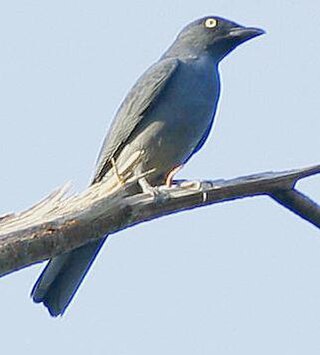
The bar-bellied cuckooshrike is a species of bird in the family Campephagidae. It is found in Thailand, Malaysia, Indonesia, and the Philippines, and its natural habitats include mangrove forest, dry forest, swamp forest, and secondary forest. The plumage varies among the subspecies, with different amounts of barring on the underparts. The International Union for Conservation of Nature (IUCN) has assessed the species as one of least-concern.

The African pied wagtail, or African wagtail, is a species of bird in the family Motacillidae.
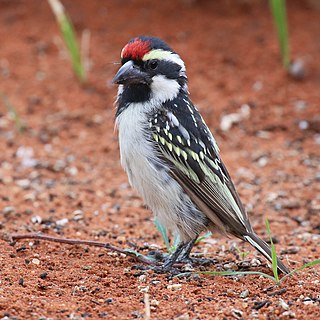
The acacia pied barbet or pied barbet is a species of bird in the family Lybiidae which is native to southern Africa.



